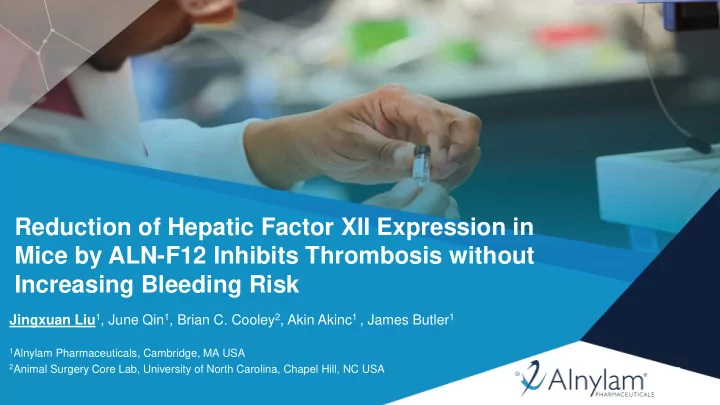

Reduction of Hepatic Factor XII Expression in Mice by ALN-F12 Inhibits Thrombosis without Increasing Bleeding Risk Jingxuan Liu 1 , June Qin 1 , Brian C. Cooley 2 , Akin Akinc 1 , James Butler 1 1 Alnylam Pharmaceuticals, Cambridge, MA USA 2 Animal Surgery Core Lab, University of North Carolina, Chapel Hill, NC USA
Acknowledgements Alnylam Pharmaceuticals UNC Chapel Hill • June Qin • Dr. Brian C. Cooley • Akin Akinc, PhD • James Butler, PhD • Daniel Freedman, PhD • Eoin Coakley, MD • Anna Borodovsky, PhD • Tracy Zimmerman, PhD • Kevin Fitzgerald, PhD 2
Investigational RNAi Therapeutics A Potential New Class of Innovative Medicines Harness natural pathway of RNAi • RNAi = RNA interference • Catalytic mechanism • Mediated by small interfering RNA or “siRNA” Therapeutic gene silencing • Any gene in genome • Distinct mechanism of action vs. other drug classes • Unique opportunities for innovative medicines Clinically validated platform • Human POC across multiple targets in healthy subjects and multiple clinical indications* * Zimmermann TS et al. Mol Ther. 2017; 25(1): 71-78 Fitzgarald K et al. N Engl J Med. 2017; 376(18): e38 3
ALN-F12: An Investigational RNAi Therapeutic Targeting FXII • siRNA conjugated to N-acetylgalactosamine (GalNAc) ligand • Efficient delivery to hepatocytes following subcutaneous (SC) administration • Targets the F12 gene encoding for FXII • Robust activity in NHPs • ED50 < 1 mg/kg; ED80 < 3 mg/kg • >50% reduction for up to 3 months at 3 mg/kg 4
FXII: A Potential Target for the Treatment of Thrombosis • Serine protease, auto-activated by contact with negatively charged surfaces ◦ PolyP, protein aggregates, DNA, RNA, etc. • FXIIa activates FXI and triggers fibrin formation (intrinsic coagulation) • FXII deficiency (Hageman trait) is not associated with disease ◦ Increased aPTT with no bleeding disorder • FXII inhibition prevents thrombosis in various venous and Weitz & Fredenburgh, Front Med , 2017, 4:19 arterial thrombosis models in mouse, rat, rabbit and baboon ◦ Antisense oligonucleotides, mAb, Corn Trypsin Inhibitor (CTI), Infestin-4 • FXII primarily expressed in hepatocytes, amenable to GalNAc-siRNA Nickel KF et al. Art Thromb Vasc Biol. 2017; 37(1): 13-20 Kenne E et al. J Intern Med. 2015; 278(6): 571-85 Yau JW et al. Blood 2014; 123(13): 2102-7 Matafonov A et al. Blood 2014; 123(11): 1739-46 5
Preclinical Evaluation of ALN-F12 for Thromboprophylaxis Overview of Mouse Thrombosis and Hemostasis Models Thrombosis Models • Venous Electrolytic Injury ◦ Electrolytic “shock” injury allows precise control of thrombosis initiation ◦ Fluorescently labeled platelets & fibrin enable real time imaging of platelet & fibrin deposition • Arterial Ferric Chloride Injury (10%) ◦ Redox-induced endothelia cell injury ◦ Measure time to occlusion Hemostasis Models • Saphenous Vein Bleeding ◦ Calculate average hemostatic time during 30 minute observation period • Tail Tip Transection ◦ Measure time to occlusion following injury 6
ALN-F12 Inhibits Venous Thrombosis in Mice Venous Electrolytic Injury Model Liver mRNA 100% F12 (Control) 48% F12 25% F12 3% F12 Liver F12 mRNA levels 1.2 Ratio to PBS Average 1.0 • Single SC Dose 0.8 • 10 days post dosing 0.6 • N=8 per group 0.4 0.2 0.0 7 PBS 0.3 mpk 0.75 mpk 10 mpk
F11-siRNA Inhibits Venous Thrombosis in Mice Venous Electrolytic Injury Model Liver mRNA Control (100% F11) 33% F11 22% F11 4% F11 Liver F11 mRNA levels 2.0 Ratio to PBS Average 1.5 • Single SC Dose 1.0 • 10 days post dosing 0.5 • N=8 per group 0.0 PBS 0.3 mpk 0.75 mpk 10 mpk 8
ALN-F12, F11-siRNA Inhibit Venous Thrombosis in Mice Real Time Images of Fibrin and Platelet Deposition in Electrolytic Injury Model Control ALN-F12 F11-siRNA Red: Fibrin Green: Platelet 9
ALN-F12 Inhibits Arterial Thrombosis in Mice FeCl 3 -induced Arterial Thrombosis Model Liver F12 mRNA levels 1.2 0.8 0.4 > 97% K/D 0.0 PBS ALN-F12 Liver F11 mRNA levels 1.5 1.0 0.5 > 98% K/D 0.0 PBS FXI-siRNA • Single SC Dose • 10 days post dosing • N=8 per group 10
ALN-F12 Does NOT Impair Hemostasis No Bleeding Phenotype at > 95% FXII or FXI Reduction • Single SC Dose • 10 days post dosing One-way ANOVA: n.s., not significant; ***, p<0.001 • N=8 per group 11
Summary Reduction of FXII by ALN-F12 Prevented Thrombosis Without Increased Bleeding Risk in Rodent Models of Thrombosis and Hemostasis • ALN-F12 reduced liver F12 mRNA and plasma FXII in a dose dependent manner in rodents and NHPs • ALN-F12 mediated reduction of FXII prevented platelet and fibrin accumulation in the Venous Electric Injury thrombosis model ◦ Dose-dependent effect ◦ Reduction of FXII >95% led to ~10 fold reduction in fibrin deposition ◦ Reduction of FXI (>95%) also reduced platelet and fibrin accumulation (~5 fold reduction in fibrin deposition) • ALN-F12 mediated reduction of FXII inhibited FeCl3 induced arterial thrombosis • > 95% reduction of F12 or F11 had no impact on bleeding time or blood loss (Saphenous Vein Bleeding, Tail Tip Transection), • Reduction of plasma FXII by ALN-F12 represents a promising approach for the prophylactic treatment of thrombosis 12
Recommend
More recommend